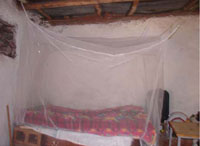11.8 Monitoring ITN utilisation
Continuous monitoring of the possession and proper use of ITNs is also very important if ITN programmes for preventing malaria are to be successful. You should visit a sample of households regularly and check:
- Whether all the nets you gave the family are physically present in the household.
- Whether the nets have been hung properly (Figure 11.5).
- Whether everyone in the household slept under the nets the previous night.
- The physical condition of the nets and advise the family to repair minor damage.
- The names of the family members who sleep under each net.
- If possible ask them what time children under five years and adults normally go to sleep in the evening; advise alternative solutions if outdoor sleeping or staying out late is an issue.
- Address any concerns or problems about net use from the household.

As a health worker providing antenatal care (ANC) and immunization services to the community, you should always ask pregnant women at every ANC visit, and parents of children at all vaccination visits, whether they have nets and whether they are using them properly. You should check if the mothers and their children slept under ITNs the previous night, and you should record their responses on the Expanded Programme of Immunization (EPI) monthly form.
As you learned from this study session, the most important components of an ITN programme in malaria prevention are distributing the ITNs correctly, maintaining high coverage, educating people on proper and consistent use, and monitoring their utilisation. You are the key person who can effectively implement all the above activities and protect people from malaria-related illnesses and deaths.
11.7 The role of the health worker in education about ITNs
